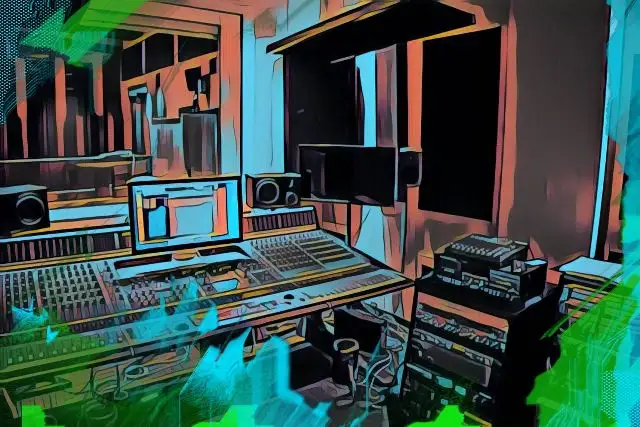Reverb is a crucial element of any professional mix. However, with so many reverb plugins on the market, picking the right reverb plugin can be difficult.
To make your search easier, we've put together a detailed list of some of the best reverb plugins available.
Let's dive in and learn more!
Different Types of Reverb
Before we dig in and start exploring some of the many reverb plugins on the market, let's start by exploring the different types of reverb plugins and why you might want to have at least one of each for your music production and mixing.
Hall Reverb
Hall reverb plugins are made to sound large, spacious, and epic. When someone mentions hall reverb, I often think of a large church, concert hall, or concert venue. This is a great style of reverb if you want to make something sound dramatic or larger than life, though it will certainly push your signals back in the mix.
Chamber Reverb
Chamber reverbs appeared in the early part of the 20th century as a way for mixing engineers to mimic the size of large spaces without having access to them. Chambers were essentially small physical rooms with several angles and ultra-reflective surfaces that sat adjacent to the recording studio.
An engineer could run audio out of the console and into a speaker in the chamber room, record the reflections in the chamber, and mix it back in with the dry vocal to give it space.
Because chambers are in small, artificial spaces, they have a much denser sound than other reverb types.
Plate Reverb
Plate reverb came about as a way to make the sound of reverb more accessible to engineers. An engineer would run a vocal signal across a large metallic plate and record the vibrations to mix back in with the dry vocal.
The sound of the plate would depend on the material that it was made out of. However, for the most part, plate reverbs sound smooth and bright. They are a number one choice for lead vocals and snares, as they keep elements toward the front of the mix.
Room Reverb
A room reverb is just what it sounds like - reverb from a room! Room reverbs are often studio room emulations made with a specific sound in mind. Engineers often use room reverbs to make sure multiple elements in a mix share the same space. You can almost think of room reverb as a tool to make multiple elements sound more cohesive.
Spring Reverb
Spring reverb works in a similar way to a plate reverb, in that a dry vocal will be sent along a piece of vibrating metal to create the illusion of space. However, rather than a large plate, a spring reverb uses a spring.
Spring reverb is a staple for guitarists, as it can be found in many tube amplifiers. As for the tone of spring reverb, we often like to think of them as multiple echoes pushed close to one another, rather than ultra-smooth reflections.
If you want to give something a vintage feel, a spring reverb is a nice touch.
Algorithmic Reverb
Algorithmic reverbs use digitally produced algorithms to create fake spaces or emulate one of the reverb types above.
Convolution Reverb
A convolution reverb uses impulse responses (IRs) or samples of physical spaces to emulate them. The beauty of convolution reverbs is that they sound very realistic, as they are made with naturally occurring reverberation in mind.
Best Convolution Reverbs
Audio Ease Altiverb
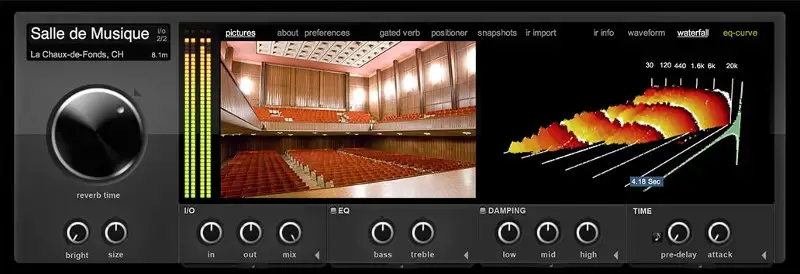
Altiverb is one of my absolute favorite convolution reverb plugins on the market today. While it's certainly one of the most expensive plugins out there and doesn't come with the most updated interface, it's super easy to dial in a high-quality sound in a pinch.
The thing that separates Altiverb from so many other reverb plugins in 2022 is the fact that it makes hyper-realistic recreations of popular spaces. This alone makes it one of the best reverb plugins that money can buy.
For example, if you wanted to hear what your song sounded like if it was played in the Taj Mahal, you could do so. On the other hand, you could just as easily dial in the exact sound of the Walt Disney Concert Hall, the Sydney Opera, and Dark Horse Recording Studio in Nashville.
Plus, there are emulations of ultra-popular reverb hardware units, including spring reverbs, plate reverbs, and digital reverb rack units. Each emulation sounds absolutely pristine, perfect for those who want the most natural reverb sound possible.
While you can certainly use it on anything, I truly love how it sounds on acoustic instruments, such as drums and guitars. For example, there are a bunch of drum room presets that you can use to put multiple drum samples in a single space to make your drums sound more cohesive.
With the 3D stereo image function, you can even choose where in the room you want your sound to come from.
If that wasn't enough, you have a bunch of weird effects to play with, as the Altiverb team recorded a number of wild places, such as cars, closets, and Alcatraz Prison!
If you're in need of an all-in-one convolution reverb, Altiverb is one of the best around.
Pros
- Tons of ultra-realistic spaces
- 3D stereo image placement
- High-quality emulations of popular reverb hardware units
Cons
- Very expensive
- The interface is a bit outdated and clunky
Slate Digital Verbsuite Classics

Slate is another great convolution reverb that comes at a fraction of the cost of Altiverb. You can either buy this plugin outright or get access to it with the Slate All Access pass, which is currently $15 per month.
The beauty of this convolution reverb plugin lies in its simplicity. You'll find large knobs on the interface paired with simple settings. Dialing in the perfect settings for your needs is easy as well. Plus, if you're not someone who likes to spend hours tweaking settings, you'll be able to choose from one of the many presets.
Slate Digital paired with Liquidsonics to develop this plugin, using unique technology compared to classic impulse responses found in other convolution reverb plugins. It does so by capturing the evolving character that is found in digital reverb modulation. The end result is a reverb that sounds smooth, rich, and ultra-dynamic.
There are many classic digital reverb emulations baked into the Verbsuite Classic reverb plugin, many of which were iconic staples of recording studios back in the day. One of the great things about this design is that it makes it super versatile. You can hop from model to model to completely alter your reverb tone.
Verbsuite can be used for many things, though I often find myself using it across an entire mix, especially if I'm going for a clean, modern mix. However, if there's one place I think it really shines, it would be on drums. The Gatey 80s Drums preset is one of my absolute favorites for toms and snare drums!
Pros
- Plenty of great presets to choose from
- Very versatile sound
- Intuitive interface
Cons
- May not be tweakable enough for some engineers
HOFA IQ Series
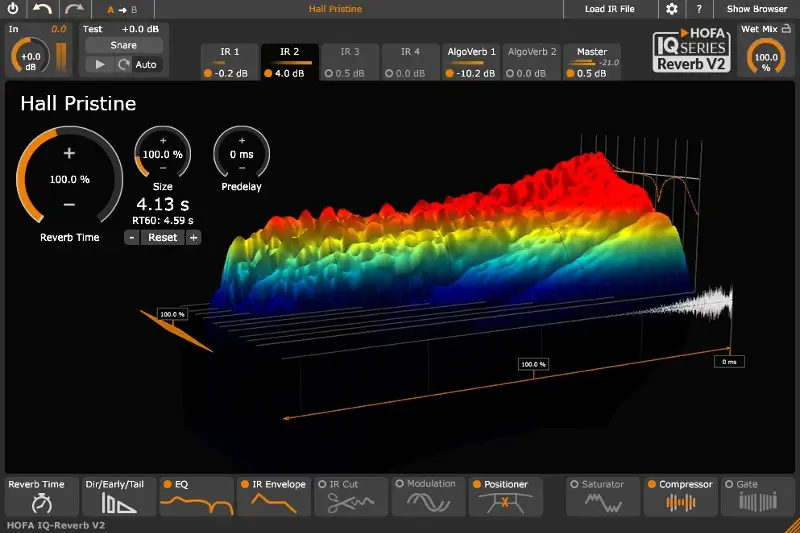
While IQ Series may seem like your average convolution reverb plugin, it comes with a super unique flavor. There's something magical about the character of the decay of this plugin. It feels a bit alien .
While I don't often find myself using this plugin across a mix, I find that it works great for pads, synths, guitar, and effects, especially when the mix needs a bit more texture.
There is a somewhat mysterious tone that the plugin is able to impart on certain instruments, often leaving me asking,
What in the world am I listening to?
The Cut and Gate tools offer unique ways to create cool effects. You'll find two unique ways to gate your IQ Series reverb, one of which delivers the classic 80s snare sound, for those who are familiar with the almighty Phil Collins, or strange, glitchy, out-of-this-world effects.
If you want to completely customize your sound, you can upload your own impulse responses by dragging and dropping them into the plugin interface. This is great for someone who already has a collection of favorite IRs that they like to use in their mixes.
Similar to Altiverb, IQ Series also has a positioner tool, which lets you change the position of where your sound is coming from in the stereo field.
Want to make it sound as if your signal is coming from the far right corner of a large stadium?
With IQ Series, you can make it happen!
One of the main downsides of IQ Series would have to be the interface. At first glance, it can get a bit confusing and overwhelming. To get the hang of it, you really have to spend some time with it.
However, with similar flexibility to Altiverb and a price that's much easier to swallow, it's a great-sounding reverb to have in your arsenal.
Pros
- Tons of unique, otherworldly sounds
- You can upload your own impulse responses
- Positioner tools let you adjust where the sound is coming from in the stereo field
Cons
- The interface can be very overwhelming for beginners
Audio Thing Fog Convolver
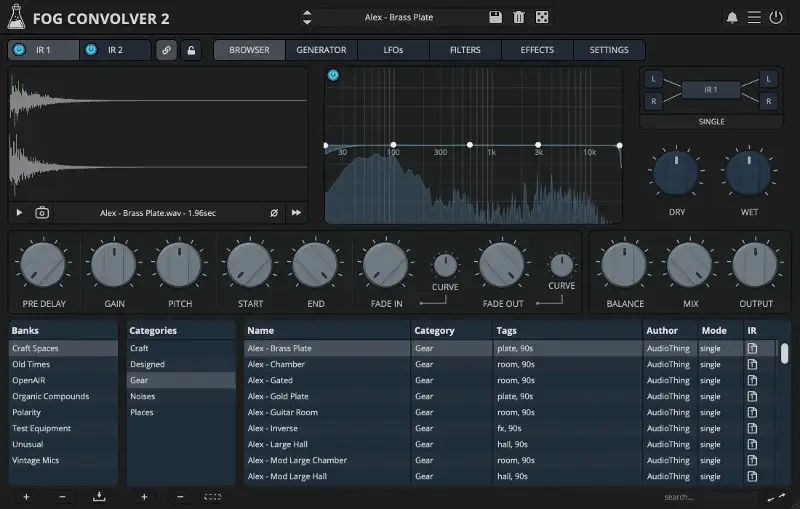
Audio Thing Fog Convolver is one of the most intuitive convolution reverb plugins on the market today. Though it's a lightweight plugin compared to some of the other convolution reverb plugins above, it is packed full of great features and won't break the bank.
You'll find more than 250 impulse responses bundled up in Audio Thing Fog Convolver, making it a super versatile plugin. Many of the IRs use a true stereo recording technique, giving you a wide and ultra-realistic sound. You can even mix and match different IRs to get unique tonal results.
Beyond its regular use for reverb, you can use Audio Thing Fog Convolver for high-quality sound design. You'll find a super-detailed list of controls for each of the impulse responses, including detailed envelopes controls, pitch controls, gain controls, and filters. Every impulse response also has ten waveforms, two LFOs, 18 destinations, and a dedicated multi-mode filter with a five-band graphic EQ for tone shaping.
Plus, the browser to filter through the various IRs is super easy to navigate.
As you might expect, you can upload a custom impulse response if you want, thanks to the intuitive drag-and-drop design. However, if you really want to get creative, you can use the built-in impulse response generator to develop your own custom spaces with a list of in-depth parameters.
Pros
- Intuitive tone-shaping controls
- Easy audition feature
- Very inexpensive
Cons
- Not the highest-quality included IR libraries
Best Algorithmic Reverbs
Relab LX480 Complete
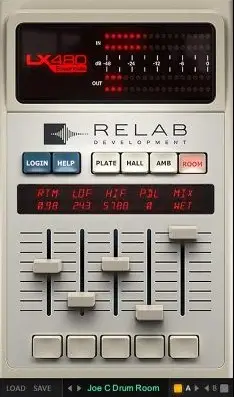
Anyone familiar with the original Lexicon 480 will be super familiar with the Relab LX480 . The original Lexicon unit is by far one of the most iconic reverb units of all time, and like the original unit, it sounds great right out of the box. While there are certainly several emulations of the Lexicon 480, I have yet to find one that sounds as good as Relab LX480.
It's one of the best reverb plugins for vocals, as it creates a smooth space without conflicting with any other mix elements.
It comes with a high-end preset manager with several signature presets from some of the best engineers in the world. You'll find a wide range of faithful emulations from some of the best reverb algorithms in the original hardware, including Hall, Random Hall, Ambience, Room/Plate, and Twin Delays.
Pros
- Smooth and clean reverb sounds
- High-end list of presets
- Sounds incredible on vocals
Cons
- Presents a learning curve for those not familiar with the original hardware
- A bit expensive
Valhalla Room
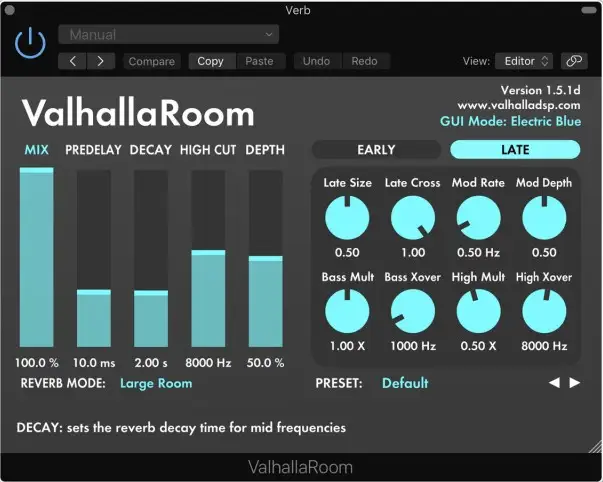
While the developer might have plenty of complex plugins to choose from, Valhalla Room is one of the cleanest and simplest reverb plugins on the market. While you can flip through different modes that impact its overall character, Valhalla Room is one of the best reverb plugins for clean and smooth room tones.
The beauty of Valhalla Room is that it sounds great on almost anything, which is likely one of the reasons it has become such a staple in the EDM realm. Plus, at only $50, you get the best bang for your buck out of most reverb plugins on this list.
I often find myself using it when I want to give something a bit more tail, such as drums, synths, or FX. It's great at widening things out as well, especially when you raise the Early Cross parameter.
Pros
- Outstanding reverb for the cost
- Tons of great sounds built-in
- Four unique algorithms
Cons
- Large, non-resizable GUI
- Not the best preset system
Valhalla Vintage Verb
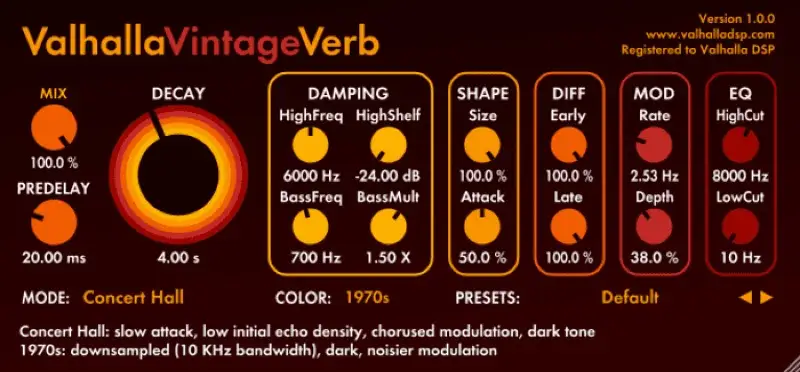
Valhalla Vintage Verb is a fun and psychedelic algorithmic reverb that is capable of plenty of cool, natural, and out-of-this-world tones. If I were to describe it in a few words, I would say that Valhalla Vintage Verb is bright and forward with large and lush tails to match.
The tones found in this reverb are very similar to what you would expect to hear in your favorite 80s songs.
If there are elements in your mix that you're looking to push forward and make appear larger than life, Valhalla Vintage Verb is a great choice. We love the fact that it comes with built-in low and high-pass filters, allowing you to clean up the extreme ends of the frequency spectrum.
You get all of this for only $50, as with every plugin in the Valhalla suite.
Pros
- Bright and lush sound right out of the box
- Simple and elegant GUI
- Unique 'Color' setting for imparting a vintage flavor
Cons
- We wish there were a few more EQ controls
- Not a very subtle sound
FabFilter Pro-R
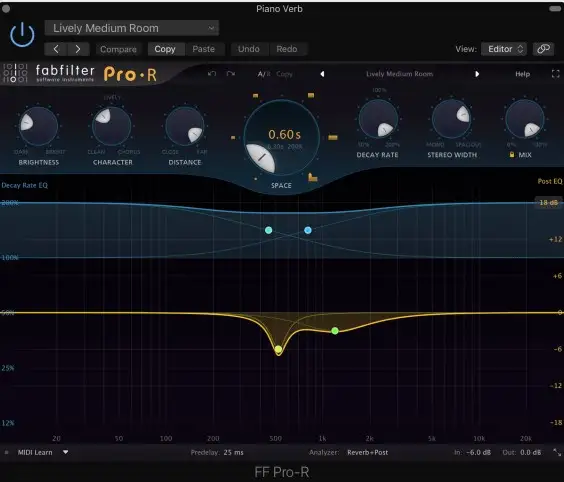
FabFilter Pro-R is one of the most transparent-sounding reverb plugins on the market, great for just about any instrument.
One of the main problems with reverb is that it can sound super muddy in your mixes if you're not careful. It can also distract the listener and sound unnatural in the context of your mix if you don't dial in the right settings. With Pro-R, you don't really have to worry about either of those issues.
If you're planning on running several instruments into a single reverb to create a cohesive space, for example, FabFilter Pro-R is an excellent choice. It has a crystal-clear tone that keeps vocals and other instruments sounding natural and spacious.
It's also surprisingly light on the CPU, great for dialing in reverb tones when you're still in the writing and recording process.
As with most FabFilter plugins, the interface is simple and easy to navigate, with large knobs at the top for your most important parameters and a parametric EQ with a spectrum analyzer.
Pros
- Great for creating unified spaces
- Onboard EQ with a spectrum analyzer
- Very clean and crisp sounding
Cons
- A lack of character can leave you wanting more in a digital mix
Lexicon PCM Native
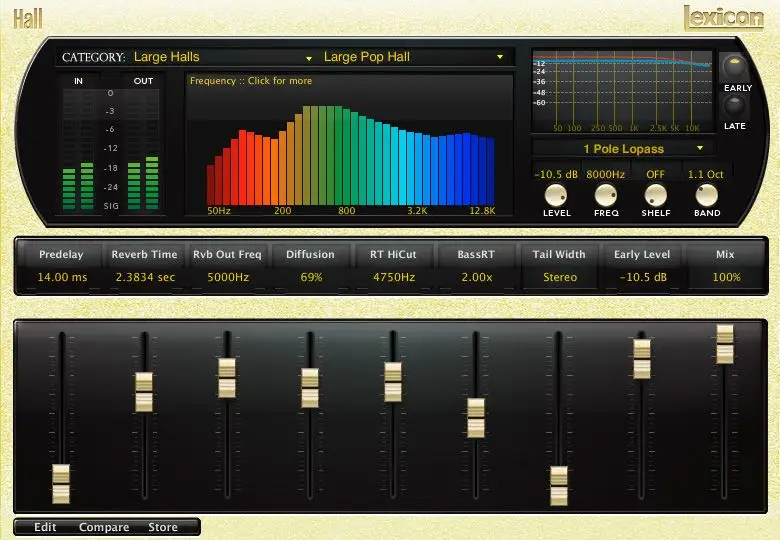
Lexicon is one of the biggest names in the algorithmic reverb realm, and this plugin may just be one of the best-sounding algorithmic reverb plugins for anyone that has the money to dole out.
Lexicon became famous back in the day for introducing some of the world's most sought-after digital reverb units. The developers claim that the same quality can be found in this plugin, and upon listening to it, we don't doubt it.
You'll find seven different reverb modes in the Lexicon plugin, great for customizing your tone for just about any instrument.
I love that you can run it in both mono and stereo, giving you greater control over the stereo imaging.
Pros
- Absolutely breathtaking sounds
- A large bundle of top-notch presets
- Very easy to use
Cons
- Outrageously expensive
Native Instruments Raum
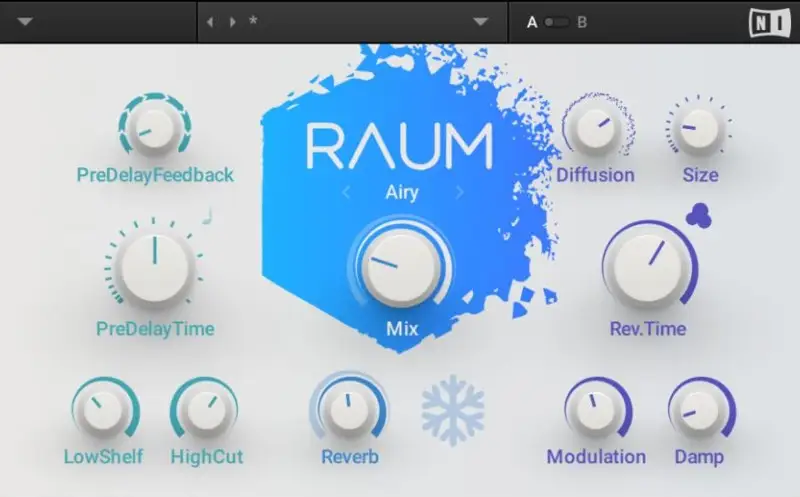
I don't often use Native Instruments effects plugins, though I truly love what Raum has to offer. This sleek and modern algorithmic reverb plugin has three modes to choose from, making it a fairly versatile option.
It sounds different from many modern reverb plugins that we've used in that you can create some pretty otherworldly sounds in a pinch.
With its clearly digital tone, it's an excellent option for synthesizers, though I often find myself using it on electric guitars too.
I love that the plugin has a BPM sync option, allowing you to set the pre-delay to the tempo of your track. This is a great feature for electronic music producers, as you can make sure your reverb is as clean and rhythmic as possible.
It also has a unique freeze option that allows you to create an interesting ambiance.
Pros
- Inexpensive algorithmic reverb
- Only has a few controls to play around with
- The unique freeze option creates a cool atmosphere
Cons
- Lacks analog warmth
Kleverb
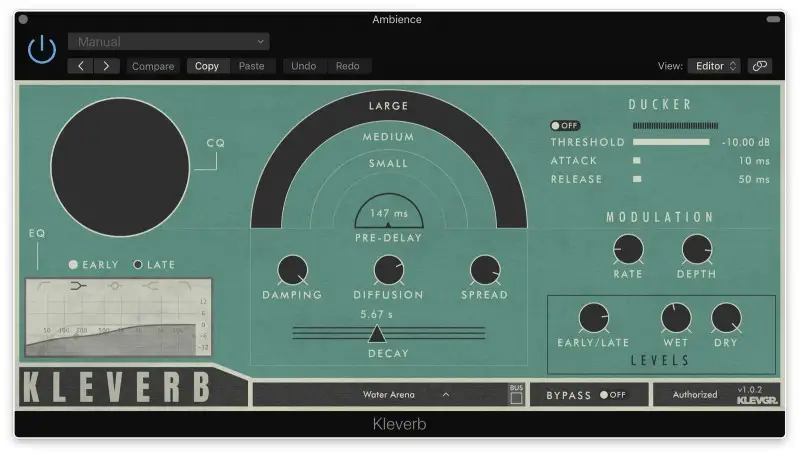
When it comes to making budget-friendly effects that can transform mixes, Klevgrand is one of my favorite companies. Kleverb is the developer's algorithmic reverb offering, which is great for crafting everything from ambient textures to drum spaces.
While it certainly isn't the most realistic reverb on this list, sometimes, realism is not the thing you're looking for!
Kleverb has an early and late reflection parameter, allowing you to mix between the two with ease. You'll also find a handy Ducker control onboard, perfect for when you want your reverb to be quieter when the instrument isn't playing.
While looks can certainly be superficial in the plugin world, the design of this plugin is nothing short of creatively encouraging.
Pros
- Excellent reverb for ethereal atmospheres
- Onboard ducker for getting the reverb out of the way
- Early and late reflections parameter
Cons
- Can introduce nasty resonances
Best Plate Reverbs
Liquidsonics Lustrous Plates
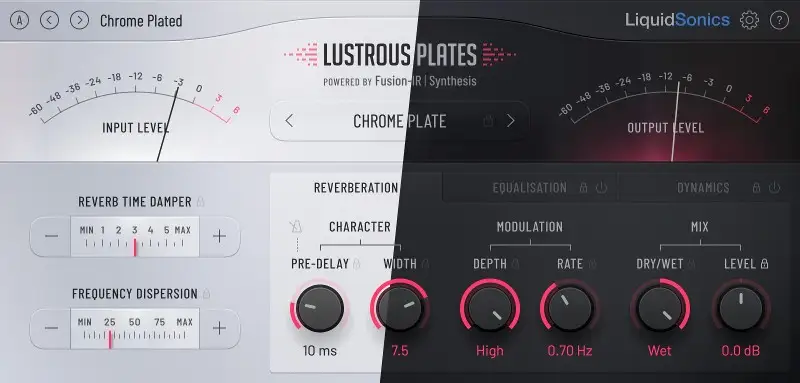
Lustrous Plates is another offering from Liquidsonics, delivering the same clean and intuitive interface as the Verbsuite Classic plugin. If you love how crispy Verbsuite sounds, just wait until you hear this one!
You'll find several different plate modes baked into this plugin, as well as their own unique plate algorithm called "Unobtanium," which is bright, thick, and lush very that pushes tracks directly to the front of your mix while filling the space around. It's an excellent reverb for snares, vocals, and other lead elements.
The plugin is very simple overall, giving you control over pre-delay, width, and modulation, as well as a mix control.
Pros
- Sleek and visually appealing interface
- Plenty of unique plate algorithms
- Pushes elements toward the front of the mix
Cons
- Some mixers might wish for a bit more control
UAD Pure Plates
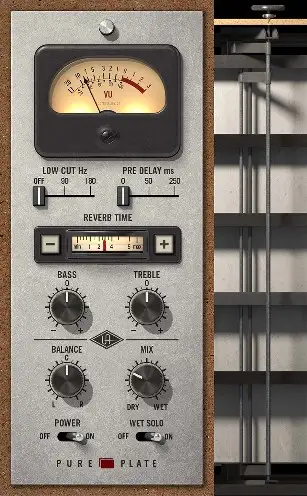
Almost anything that UAD puts out sounds fantastic, and UAD Pure Plates is no exception. While there aren't many plate options built into this plugin, it doesn't really need them. Overall, it's a very straightforward and intuitive plugin with high-fidelity sounds.
The plate algorithm is full, smooth, and bright; great for pushing things to the front of a mix. I often find myself using it on vocals, snares, and guitars. Compared to the Liquidsoncs plate plugin, this one has more of a vintage tone.
One of the cool things about this plugin is that you can use it in the monitoring section if you have the UA Console App.
Pros
- Rich and dense tone
- Light on CPU
- Very easy to work with
Cons
- Setting the arbitrary pre-delay can be a bit challenging
Soundtoys Little Plate

Soundtoys is one of the best plugin developers for vintage tones. In classic Soundtoys fashion, Little Plate is as simple as it can possibly be. Note that it's certainly not the strongest reverb on this list, and I wouldn't recommend it for putting elements in a large space. However, when you need to give one of your sounds a bit of added tone, it's an excellent option.
It works on just about anything and couldn't be easier to dial in. You only have a few controls to work with, including the Decay time, which is in seconds, a mix knob, a low-cut filter, and a Mod switch, which introduces a bit of creamy modulation to give your signal some character.
The infinite decay mode is awesome for creating neat ambiances.
Pros
- Minimal controls make it easy to work with
- Infinite decay mode makes unique ambiances
- Very light on CPU
Cons
- Doesn't create large spaces very well
UAD EMT 140
The UAD EMT 140 was made to look like the original hardware unit, and with its simple layout, it is one of the easiest plugins to master.
As with the original unit, the UAD EMT 140 plugin is smooth and pretty, including three distinct plate emulations that cover a pretty large tonal bandwidth. UAD arranged them in a logical order too, making the A plate the brightest, the B plate with a bit more low-end, and the C plate with a full tone.
As with the other plates above, the UAD EMT 140 is great when you need to push your sounds toward the front of the mix while still creating space around them.
The depth knob can make your reverb sound full and thick, while the width knob can help you dial it in a way that fits the stereo spread of your mix.
Pros
- Three distinct plate sounds
- Smooth and pretty sound
- Offers plenty of control
Cons
- A bit expensive for a plugin that's only based on a single reverb type
Arturia Rev Plate-140
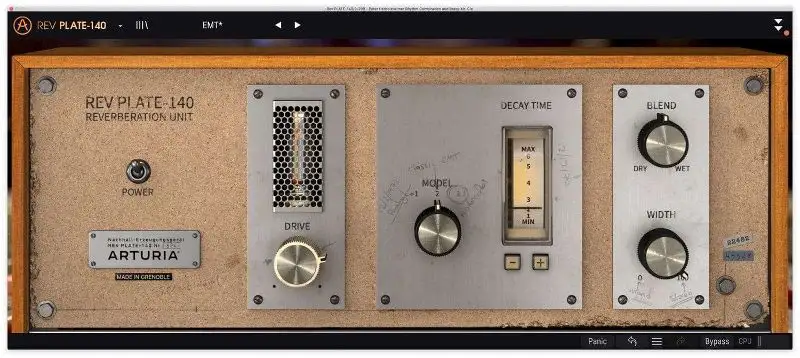
The Arturia Rev Plate-140 is an excellent emulation of the original 60 EMT unit. Like the original, it delivers silky smooth, resonant plate tones, great for vocal performances and other leads. The plate algorithm is easily adjustable with a few onboard controls, including a blend knob, width knob, decay time parameter, post-equalizer, and more.
You can switch between three different plate models, each of which was beautifully modeled with authentic damping. We love the fact that Arturia took it a step further (as they typically do) and added a chorus effect that you can use pre or post-reverb to get that extra richness.
Overall, Arturia is one of the best developers around when it comes to modeling vintage gear, and the team absolutely killed it with the Arturia Rev Plate-140.
Pros
- Additional chorus and EQ controls for further mixing
- Three distinct plate models to choose from
- Excelllent vintage tone
Cons
- A bit expensive for a plugin that's only based on a single reverb type
Best Spring Reverbs
PSP Springbox

If you're working with electric guitars, having a spring reverb in your arsenal can be extremely helpful, especially if you're planning on recording your guitar with a DI.
The good thing is that we have plugins like PSP Springbox. This plugin was beautifully modeled after high-end hardware spring reverb units.
Of course, PSP Springbox isn't only for guitars. You can use it to create a myriad of strange and psychedelic effects, perfect for vintage reggae or rock tones.
As with many PSP plugins, you get low CPU usage and a warm, vintage tone.
Pros
- Four unique spring configurations
- Intuitive spread and diffusion controls
- Sounds amazing on guitars
Cons
- Cannot alter the individual springs
- A/B option is not that great
AudioThing Springs
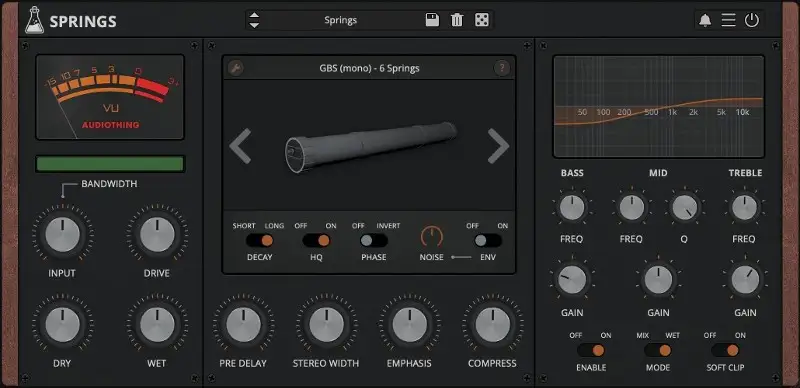
Audio Thing Springs is a plugin that features a collection of vintage spring emulation with an authentic Baxandall EQ to shape your reverb tone as you please. You'll find eight types of springs, ranging from a small, battery-powered, single-spring unit to a long six-spring pipe.
With a mix of modeling and convolution reverb, AudioThing was able to deliver a spring reverb that sounds ultra-realistic.
There are 50 presets to get you started and an intuitive interface with photos of the spring units for you to explore. The included EQ is a great feature, as many springs often need a bit of tone-shaping for them to fit nicely in mixes anyway.
For a funky, vintage, psychedelic tone, you really can't go wrong with AudioThing Springs.
Pros
- Wide range of spring emulations to choose from
- Built-in Baxandall EQ for easy tone-shaping
- Simple and easy-to-explore interface
Cons
- Not a great fit for normal reverb tones
Softube Spring Reverb
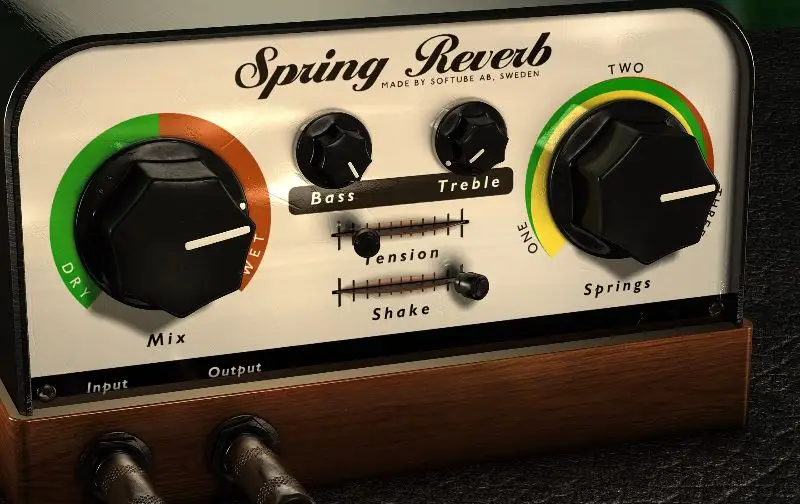
If you want a simple spring reverb plugin to introduce character and personality to your mixes, it doesn't get much easier than the Softube Spring Reverb plugin. This authentic recreation of a vintage reverb unit includes everything you'd expect from a spring reverb, as well as some more unique options, such as an automated shake control for procuring those thundering spring effects.
Softube has some of the best physical modeling techniques in the industry, and even with its low cost, Softube Spring Reverb shows it.
You can control the number of springs between 1 and 3, manipulating the sound by altering their tension.
Overall, Softube Spring Reverb is an excellent tool if you want to add vintage tonality to your mix.
Pros
- Nicely laid out interface
- Versatile list of spring tones
- Integrated shake control
Cons
- Not the most flexible tone-shaping controls
Best Experimental Reverbs
Zynaptiq Adaptiverb
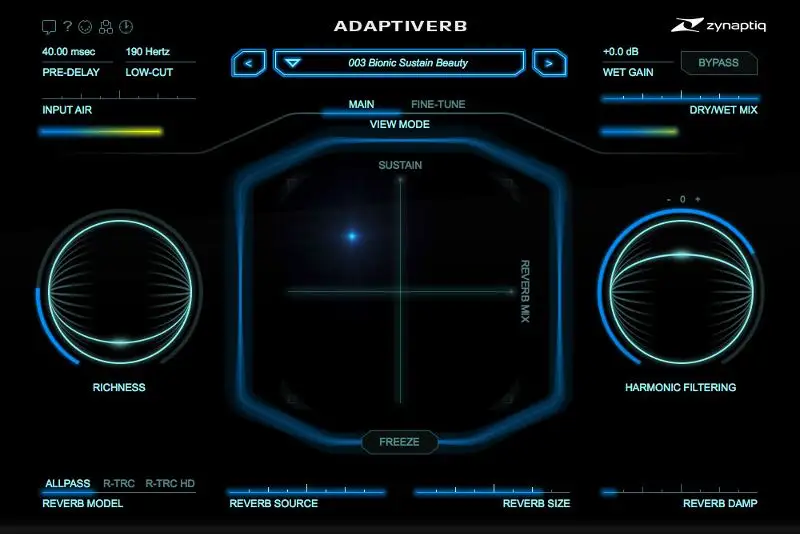
If you're looking to create cool effects and enhance your electronic music production, Adaptiverb is a great plugin to get you started. Zynaptiq has come up in the plugin development world using cutting-edge technology to craft out-of-this-world plugins. Adaptiverb certainly lives up to its freaky reputation.
With ray tracing and adaptive learning technology, Zynaptiq is an unprecedented piece of software. The software works to resynthesize the original sound so the reverb tails don't get in the way of the rest of your mix.
You can even create drone-like synth sounds by using the Hold button or quantizing real-time harmonies. It's truly an instrument all on its own.
Pros
- Wide variety of interesting effects
- More like an instrument for reverb music production
- Practical number of controls
Cons
- Very high latency
- Not the best on CPU
Arturia Rev INTENSITY
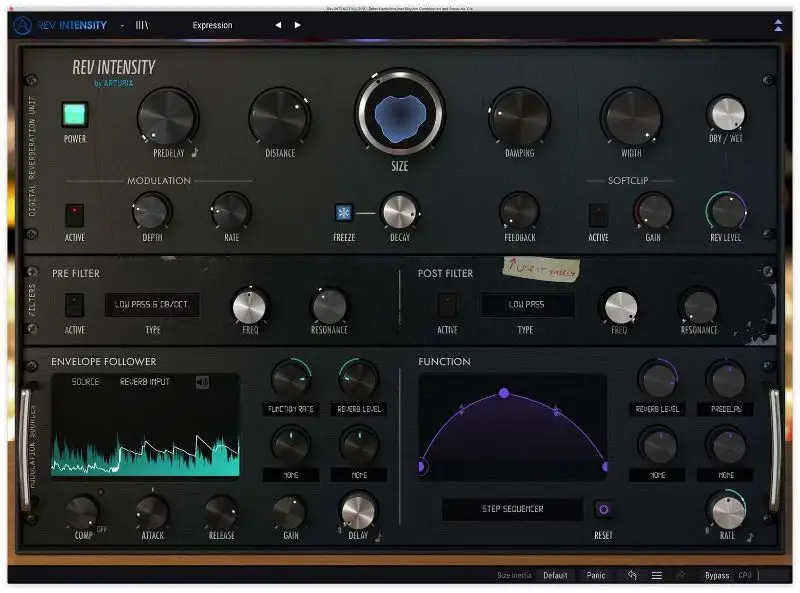
Arturia Rev INTENSITY offers seemingly limitless spatial possibilities in a unique plugin that is just as easy to use as it is easy on your CPU. In fact, it might just be one of the most progressive and innovative reverb sound design tools on the market today, great for those who want cinematic and experimental tones.
I absolutely love the Size parameter, as it allows you to dial in the perfect amount of width with ease.
However, the true focus of this plugin is the modulation section, which gives your reverb plenty of unique character. You can even get creative with the envelope follower to shape your sounds as you please, going far above and beyond what you would expect from a standard reverb plugin.
The capability of Arturia Rev INTENSITY is so significant that it'd be impossible to condense it into a few paragraphs. It's truly a plugin that you must try for yourself.
Pros
- Innovative sonic possibilities
- Plenty of modulation parameters for added character
- Great for sound design
Cons
- Complex for your average reverb needs
Liquidsonics Reverb Foundry Tai Chi
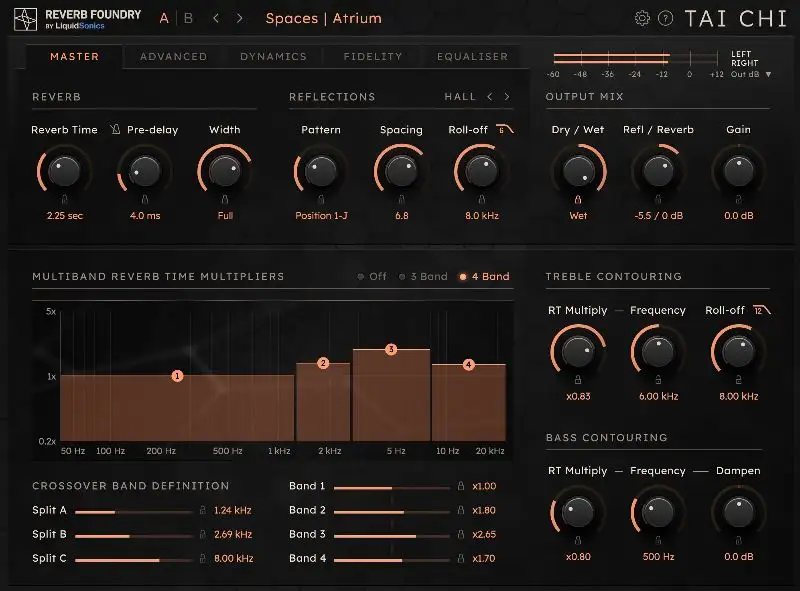
No matter what kind of reverb you're looking for, you'll likely be able to find it in Liquidsonics Tai Chi . This Atmos-compatible reverb plugin delivers everything from cinematic ethereal spaces to tight rooms. The overall sound is very lush, great for melodic instruments like vocals, guitar, electric piano, and synth.
There are tons of unique features baked into this plugin, including multi-band reverb editing, equalization, and chorusing. It truly sits in the center of contemporary class and old-school vintage warmth.
It's certainly not a reverb plugin for the squeamish, as it offers total mastery over control, allowing you to manipulate the flow and movement of your mix in any way you please.
Plus, with multi-channel setups, you can work all the way up to 7.1.6m which is pretty astounding.
Pros
- Extremely flexible algorithmic reverb
- Unique muti-band adjustability
- Dynamics control section
Cons
- Complex for your average reverb needs
Baby Audio Spaced Out
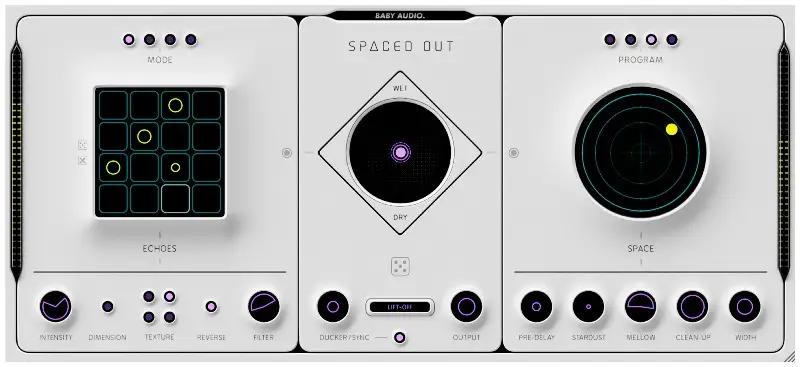
Baby Audio Space Out is one of the best reverb plugins for anyone that wants to get experimental with modulation sounds. This is because this plugin combines reverb, delay, and modulation, all in a seamless, left-to-right workflow.
You can add lush and otherwordly textures to your instruments and vocals with more than 50 unique effects happening beneath the surface.
Some of the top features found in Baby Audio Spaced Out include the 16-step delay sequencer, the three delay modes, the ultra-wide and motion dimension modes, the playback reverse, and the analog-filtered high and low-pass filters.
Overall, it is an excellent reverb plugin for someone who produces electronic music and wants something they can experiment with.
Pros
- Tons of great spatial effects
- Killer-sounding presets
- Very cool space-age interface
Cons
- We wish you had more control over the modulation
Best Free Reverbs
OrilRiver 2
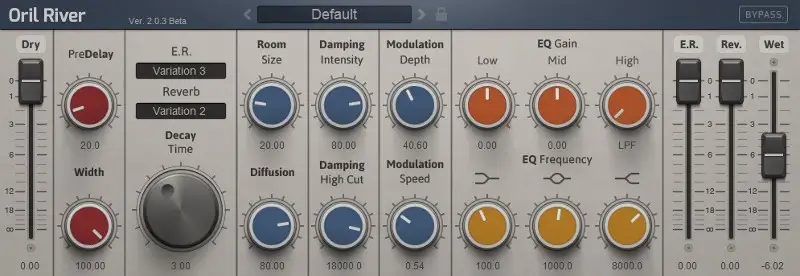
OrilRiver 2 is a great-sounding free reverb plugin that comes with plenty of features built-in, including a number of high-end room and hall emulations.
You'll find 12 early reflection options, three EQ bands for additional tone-shaping, easy-to-use modulation controls, and much more!
You'll find plenty of classic reverb parameters onboard, including Stereo Width, Damping, Room Xie, Pre-Delay, Diffusion, Damping, and more, helping you to shape the reverb to the feel of your mix.
For a free plugin, the graphical interface looks great! While I don't often like to base my love for plugins on superficiality, it's certainly more inspiring to use a plugin that looks good.
Now, there aren't many sounds to write home about in OrilRiver 2, though for a free plugin, we can't really complain. However, you'll most likely be able to get all of these sounds out of the stock reverb in your DAW.
With that said, it can certainly be nice to have another option.
Pros
- Clean and crisp hall and reverb tonality
- Aesthetically pleasing GUI
- Great for generating flutter echo on drums
Cons
- Very stock-like reverb sounds
TAL Reverb 4
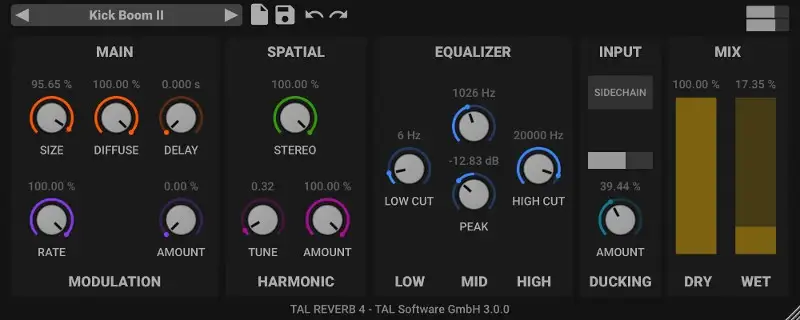
TAL makes some of the best free plugins, and TAL Reverb 4 is an excellent free reverb option for those who want a quality-sounding plate that delivers a vintage tone with 80s character.
It has a very diffused sound with modulation controls, giving you a fast build-up time and long reverb tails to create tons of space around your source material.
It truly works well on just about any instrument, is super easy to use, and is light on your CPU.
You'll find plenty of great presets to get you started, a handy ducking knob to get your reverb out of the way when using it in busier mixes, and a handy wet/dry parameter to dial in the perfect amount of reverb tone.
Pros
- Added versatility with modulation parameters
- Crisp, 80s-style plate sound
- Ducking parameter onboard
Cons
- Rich and dense sound can take up tons of space in busy mixes
Analog Obsession Room 041
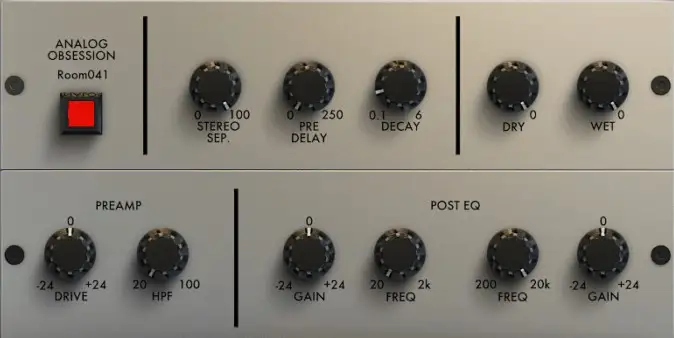
Analog Obsession Room 041 is a free reverb plugin and the first reverb plugin ever from Analog Obsession. The GUI looks nice at first sight, offering a simple-looking interface with a few unique additions.
You get a bunch of controls to get you started, including a pre-delay, a decay, and a stereo separation control.
On the upper half of the GUI, you find a mix control, and on the lower half, you have a nice-sounding preamp section and a Post-EQ. It's always interesting to see preamp sections on reverb plugins, and it adds a nice bit of drive to your signal.
Of course, based on the name, it's pretty easy to assume that this reverb VST was based on the EMT-140.
The plugin itself is very simple and easy to get the hang of, perfect as an introduction to the Analog Obsession realm.
Pros
- Simple and intuitive GUI
- Very light on the CPU
- Separate dry and wet controls
Cons
- Plate sound is pretty basic
Cymatics Space Lite
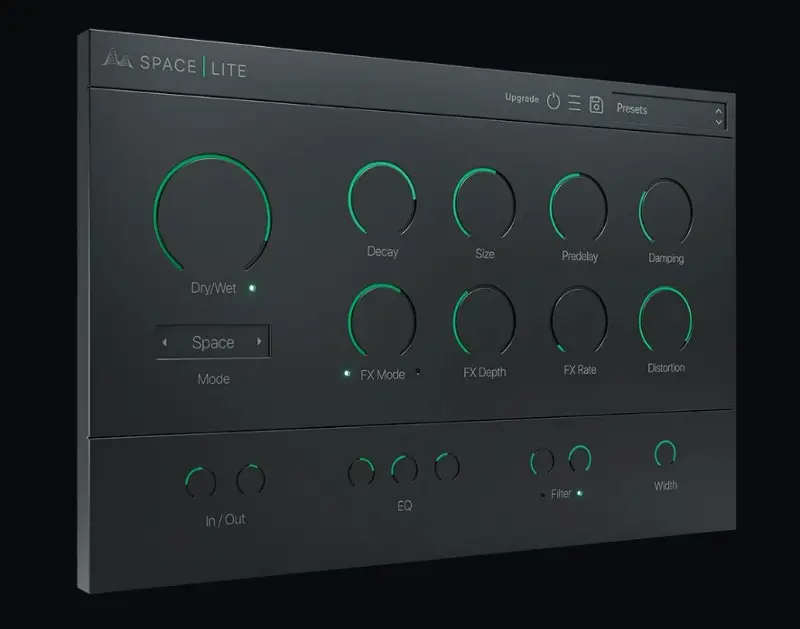
Cymatics recently released the third version of its Space Lite plugin, which comes with plenty of customizable features. While the plugin definitely looks simple, it's a complex plugin that can add width and depth to your mix in unique ways.
The reverb is great for vocals, synths, drums, percussion, and all other kinds of instruments. There are 20 reverb modes built into the plugin, as well as a few additional FX, such as chorus, flanger, pitch, and phaser. The cool thing about these FX is that they only impact the reverb signal, so you can make crazy, psychedelic effects on your reverb while leaving everything else dry.
All of these FX can be combined with the powerful onboard EQ, distortion, and filter for even further processing
Pros
- Very easy for beginners to use
- Tons of built-in FX besides reverb
- Slick and modern interface
Cons
- Only comes in 64-bit
Fuse Audio Labs VREV-666
Fuse Audio Labs recently released a vintage-sounding spring reverb plugin based on the ultra-rare VREV-666 from the early 1960s. The original hardware unit was meant to deliver an unpredictable vibe, which is exactly what this unit does.
The VREV-666 isn't meant to sound ultra-realistic, and that is what makes it such a beautiful reverb. You can send a signal through the springs to get a sound that is charismatic and bright. Whether you need to add a gritty, springy room tone to your guitars or add some driven ambiance to your vocals, VREV-666 is an excellent reverb to get the job done.
Pros
- Very simple interface
- Effect Limiter knob
- Light on CPU
Cons
- Not many controls
Creating the Ultimate Space In Your Mix
The reverb that you ultimately choose can make a HUGE difference in how your mix turns out. We've discussed a number of reverb types and how you can use them to transform your mixes into something great.
Make sure to check out some of the reverb plugins above and demo them if you can to see if they work for your needs.
With these plugins in your arsenal, you'll be well on your way to crafting more professional-sounding mixes.


